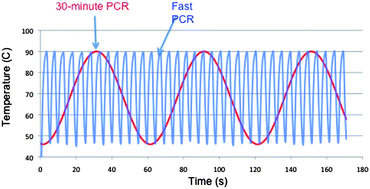Under-three minute PCR: Probing the limits of fast amplification
Abstract
Nucleic acid amplification is enormously useful to the biotechnology and clinical diagnostic communities; however, to date point-of-use PCR has been hindered by thermal cycling architectures and protocols that do not allow for near-instantaneous results. In this work we demonstrate PCR amplification of synthetic SARS respiratory pathogenic targets and bacterial genomic DNA in less than three minutes in a hardware configuration utilizing convenient sample loading and disposal. Instead of sample miniaturization techniques, near-instantaneous heating and cooling of 5 μL reaction volumes is enabled by convective heat transfer of a thermal fluid through porous media combined with an integrated electrical heater. This method of rapid heat transfer has enabled 30 cycles of PCR amplification to be completed in as little as two minutes and eighteen seconds. Surprisingly, multiple enzymes have been shown to work at these breakthrough speeds on our system. A tool for measuring enzyme kinetics now exists and can allow polymerase optimization through directed evolution studies. Pairing this instrument technology with modified polymerases should result in a new paradigm for high-throughput, ultra-fast PCR and will hopefully improve our ability to quickly respond to the next viral pandemic.

- This article is part of the themed collection: Coronavirus articles - free to access collection

 Please wait while we load your content...
Please wait while we load your content...